Ghazni (formerly Ghazna) is a city in central Afghanistan. It may also refer to:
Ghazni (formerly Ghazna) is a city in central Afghanistan. It may also refer to:

Ghazni, historically known as Ghaznain (غزنين) or Ghazna (غزنه), also transliterated as Ghuznee, and anciently known as Alexandria in Opiana, is a city in southeastern Afghanistan with a population of around 190,000 people. The city is strategically located along Highway 1, which has served as the main road between Kabul and Kandahar for thousands of years. Situated on a plateau at 2,219 metres (7,280 ft) above sea level, the city is 150 kilometres (93 mi) south of Kabul and is the capital of Ghazni Province. The name Ghazni drives from the Persian word "ganj", meaning ‘treasure’.

Ghazni is one of the 34 provinces of Afghanistan, located in southeastern Afghanistan. The province contains 19 districts, encompassing over a thousand villages and roughly 1.3 million people, making it the 5th most populous province. The city of Ghazni serves as the capital. It lies on the important Kabul–Kandahar Highway, and has historically functioned as an important trade center. The Ghazni Airport is located next to the city of Ghazni and provides limited domestic flights to Afghanistan's capital, Kabul.
The Ghaznavid dynasty or the Ghaznavid Empire was a Persianate Muslim dynasty and empire of Turkic mamluk origin, ruling at its greatest extent, large parts of Persia, Khorasan, and the northwest Indian subcontinent from 977 to 1186. The dynasty was founded by Sabuktigin upon his succession to the rule of Ghazna after the death of his father-in-law, Alp Tigin, who was an ex-general of the Samanid Empire from Balkh, north of the Hindu Kush in Greater Khorasan.

Abu Mansur Nasir al-Din Sabuktigin, also spelled as Sabuktagin, Sabuktakin, Sebüktegin and Sebük Tigin, was the founder of the Ghaznavid dynasty, ruling from 367 A.H/977 A.D to 387 A.H/997 A.D. In Turkic the name means beloved prince.

Abu al-Qasim Mahmud ibn Sabuktigin, usually known as Mahmud of Ghazni or Mahmud Ghaznavi, was ruler and Sultan of the Ghaznavid Empire, ruling from 998 to 1030. At the time of his death, his kingdom had been transformed into an extensive military empire, which extended from northwestern Iran proper to the Punjab in the Indian subcontinent, Khwarazm in Transoxiana, and Makran.

Alp-Tegin, or Alptekin, was a Turkic slave commander of the Samanid Empire, who would later become the semi-independent governor of Ghazna from 962 until his death in 963.
Khwarazmshah was an ancient title used regularly by the rulers of the Central Asian region of Khwarazm starting from the Late Antiquity until the advent of the Mongols in the early 13th-century, after which it was used infrequently. There were a total of four families who ruled as Khwarazmshahs—the Afrighids (305–995), Ma'munids (995–1017), the line of Altuntash (1017–1041), and the most prominent ones, the Anushteginids (1097–1231). Like other contemporary Central Asian titles, such as Afshin and Ikhshid, the title of Khwarazmshah is of Iranian origin.
The Al-i Muhtaj or Muhtajids was an Iranian or Iranicized Arab ruling family of the small principality of Chaghaniyan. They ruled during the 10th and early 11th centuries.

Masʽud I of Ghazni, known as Amīr-i Shahīd, was sultan of the Ghaznavid Empire from 1030 to 1040. He rose to power by seizing the Ghaznavid throne from his younger twin Mohammad, who had been nominated as the heir upon the death of their father Mahmud of Ghazni. His twin was shortly blinded and imprisoned. However, when much of Masʽud's western domains had been wrested from his control, his troops rebelled against him and reinstated Mohammad to the throne.
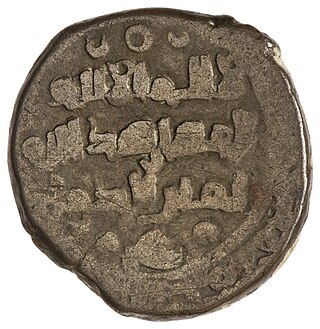
Bahram-Shah was Sultan of the Ghaznavid Empire from 25 February 1117 to 1152. Son of Mas'ud III and Gawhar Khatun, sister of Sanjar, sultan of the Great Seljuq Empire. During his entire reign, his empire was a tributary of the Great Seljuq Empire.
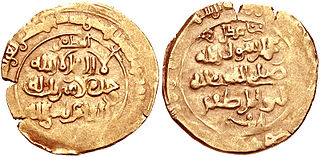
Ibrahim of Ghazna was sultan of the Ghaznavid empire from April 1059 until his death in 1099. Having been imprisoned at the fortress of Barghund, he was one of the Ghaznavid princes that escaped the usurper Toghrul's massacre in 1052. After his brother Farrukh-Zad took power, Ibrahim was sent to the fortress of Nay, the same fortress where the poet Masud Sa'd Salman would later be imprisoned for ten years.
The Mikalid family, also known as the Mikalis, was a prominent Iranian aristocratic family of Khorasan from the 9th century to the 11th century. They were descended from the pre-Islamic nobility of Samarkand.
Abuʾl-Ḥasan al-Qāsim Aḥmad ibn Ḥasan Maymandī was a Persian vizier of the Ghaznavid ruler Mahmud of Ghazni and the latter's son Mas'ud I of Ghazni.
Abu Bakr Lawik was a ruler of Ghazna from the Lawik dynasty. He was most likely a vassal of the Samanid Empire. In 962, the Turkic slave commander Alp-Tegin captured Ghazna after besieging the Citadel of Ghazni for four months. However, a few years later, Lawik managed to re-capture the town from Abu Ishaq Ibrahim, the son and successor of Alp-Tegin. This was not to last long; Abu Ishaq Ibrahim shortly returned to the town with Samanid aid, and took control of the town once again. Abu Bakr Lawik is thereafter no longer mentioned; he died before 977, the year that Ghaznavid control was established in Ghazna.
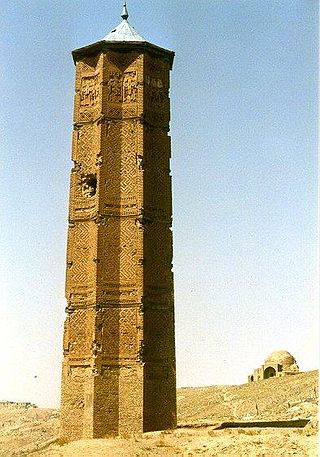
Ghazni is a city in southeastern Afghanistan, which served as the capital of the Ghaznavid Empire from 977 to 1163.

Bilgetegin was a Turkic officer, who was the Samanid governor of Ghazna from 12 November 966 to 975. He was successor of Abu Ishaq Ibrahim of Ghazna.

The Ghazni Minarets are two elaborately decorated minaret towers located in Ghazni city, central Afghanistan. They were built in middle of the twelfth century and are the only surviving elements of the mosque of Bahram Shah. The two minarets are 600 meters apart and lie in an open plain, north-east of Ghazni city.
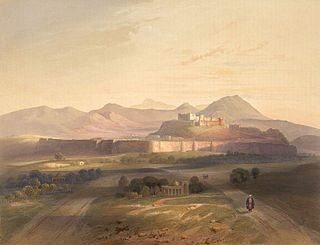
The Lawīk dynasty was the last native dynasty which ruled Ghazni prior to the Ghaznavid conquest in the present-day Afghanistan. Lawiks were originally Hindus, but later became Muslims. They were closely related to the Hindu Shahis, and after 877, ruled under the Hindu Shahi suzerainty.
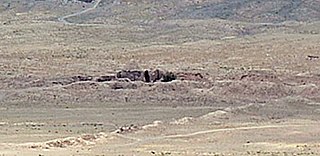
The Palace of Sultan Mas'ud III is a Ghaznavid palace in Ghazni, Afghanistan. The palace was built in 1112 by Sultan Mas'ūd III (1099-1114/5), son of Ibrahim of Ghazna.

Mas'ūd III of Ghazna, was a sultan of the Ghaznavid Empire and son of Ibrahim of Ghazna.